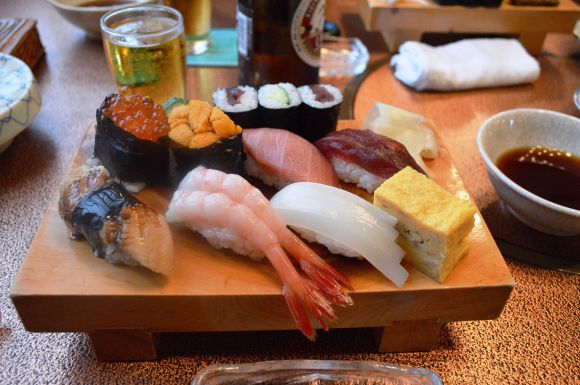Unless sushi train restaurants add a new dish to their menus, the wasteful trend looks set to continue.
In Japan, sushi is traditionally made with two vital ingredients: a neta topping, usually made from raw seafood, and shari, specially prepared rice commonly seasoned with a combination of salt, sugar and vinegar. While various types of sushi exist, in forms like temaki (hand-rolled), and gunkanmaki (warship roll), they all have one common ingredient: rice.
Revolving sushi train restaurants serve up hundreds of these rice-based morsels every day, so when customers spot fellow diners discarding one of the cuisine’s most vital ingredients, it’s sure to get sushi-lovers all riled up.
▼ Pictures of rice left behind on diners’ plates first started emerging four years ago, as customers seated next to wasteful consumers gaped at the shameless display of nonchalance and extravagance.
熊本本山スシローなう。
— かずき (@kazuboo4) May 6, 2012
横の客…めっちゃ贅沢食いやっとった。
この写真の軍艦巻はイクラです。
写真には、見えませんが、中のイクラだけを拾い上げて食べてました。
他のシャリも、上だけ食べてシャリは残すという贅沢なやつ。やばいなこいつ。 pic.twitter.com/k5sMmpqK
In Japan, children are taught that “Every grain of rice has seven fortune gods,” so leaving behind even one grain at the end of a meal is considered rude and disrespectful.
https://twitter.com/jmmkr/status/302614525578989568Still, that appears to mean nothing to body-conscious young women these days, as they choose to ditch the extra carbohydrates from the rice, preferring to fill up on the low-calorie toppings in front of them instead.
https://twitter.com/ngcykn/status/569028634419204096It’s a trend that shows no signs of stopping, as this Twitter user recently pointed out with a trio of images gathered from social media. These photos were posted by young women who said they were leaving sushi rice behind in order to watch their waistlines.
https://twitter.com/tmato30kcal/status/777819187955666944Since sharing the images, along with the note that more and more young women are following suit, the tweet received more than 40,000 retweets, with fellow sushi lovers weighing in with their thoughts on the unrelenting trend.
“This is disgusting and wasteful – they ought to be ashamed.”
“As long as they’re paying for it, it shouldn’t matter whether they eat the rice or not.”
“This is incredibly disrespectful to Japan’s farmers and farming communities.”
“They should create new dishes without rice for these types of women and charge them the same as normal.”
“Why don’t these women just buy sashimi from the supermarket and eat it at home instead?”
Although commonly mistaken for sushi, sashimi is thinly sliced raw fish which may or may not be served with rice. According to a Japanese media report, out of all the well-known sushi restaurants in Japan, only one – Hamazushi – offers sashimi on their permanent menu. While other popular chains like Kappa Zushi, Genki Sushi, Sushiro, and Kura Zushi might offer sashimi as part of special campaigns from time to time, it’s not always possible to order sushi without rice. With so many precious grains going to waste as customers try to watch their waistlines though, it might be time for sushi train restaurants to rethink their menus.
Source: Itai News
Top Image: Twitter/@ngcykn
Insert Image: Wikimedia Commons/Nandaro


 J-rock legend Gackt says he only eats the fish part of his sushi, never touches the rice
J-rock legend Gackt says he only eats the fish part of his sushi, never touches the rice Seven reasons to eat sushi (other than because it tastes great)
Seven reasons to eat sushi (other than because it tastes great) Carb-free sushi? Japanese sushi restaurant ditches the rice in its new menu items
Carb-free sushi? Japanese sushi restaurant ditches the rice in its new menu items Japan’s oldest sushi train serves up unorthodox Blueberry Cream Sushi
Japan’s oldest sushi train serves up unorthodox Blueberry Cream Sushi Make sushi in seconds with smart ingredient hack from Don Quijote
Make sushi in seconds with smart ingredient hack from Don Quijote McDonald’s new Happy Meals offer up cute and practical Sanrio lifestyle goods
McDonald’s new Happy Meals offer up cute and practical Sanrio lifestyle goods All-you-can-drink Starbucks and amazing views part of Tokyo’s new 170 meter-high sky lounge
All-you-can-drink Starbucks and amazing views part of Tokyo’s new 170 meter-high sky lounge More foreign tourists than ever before in history visited Japan last month
More foreign tourists than ever before in history visited Japan last month Starbucks reopens at Shibuya Scramble Crossing with new look and design concept
Starbucks reopens at Shibuya Scramble Crossing with new look and design concept Beautiful Sailor Moon manhole cover coasters being given out for free by Tokyo tourist center
Beautiful Sailor Moon manhole cover coasters being given out for free by Tokyo tourist center Studio Ghibli glasses cases let anime characters keep an eye on your spectacles
Studio Ghibli glasses cases let anime characters keep an eye on your spectacles Tokyo luxury hotel offers month-long stays with free breakfasts, might be cheaper than apartment
Tokyo luxury hotel offers month-long stays with free breakfasts, might be cheaper than apartment Mister Donut ready to make hojicha dreams come true in latest collab with Kyoto tea merchant
Mister Donut ready to make hojicha dreams come true in latest collab with Kyoto tea merchant Hamster abandoned at Tokyo ramen restaurant gets new home
Hamster abandoned at Tokyo ramen restaurant gets new home Inflation making penguins in Japan unhappy with aquarium’s switch to cheaper fish
Inflation making penguins in Japan unhappy with aquarium’s switch to cheaper fish Disney princesses get official manga makeovers for Manga Princess Cafe opening in Tokyo
Disney princesses get official manga makeovers for Manga Princess Cafe opening in Tokyo Beautiful new Final Fantasy T-shirt collection on the way from Uniqlo【Photos】
Beautiful new Final Fantasy T-shirt collection on the way from Uniqlo【Photos】 Is the new Shinkansen Train Desk ticket worth it?
Is the new Shinkansen Train Desk ticket worth it? Foreign English teachers in Japan pick their favorite Japanese-language phrases【Survey】
Foreign English teachers in Japan pick their favorite Japanese-language phrases【Survey】 Japanese convenience store packs a whole bento into an onigiri rice ball
Japanese convenience store packs a whole bento into an onigiri rice ball We try out “Chan Ramen”, an underground type of ramen popular in the ramen community
We try out “Chan Ramen”, an underground type of ramen popular in the ramen community Studio Ghibli releases Kiki’s Delivery Service chocolate cake pouches in Japan
Studio Ghibli releases Kiki’s Delivery Service chocolate cake pouches in Japan Japan’s bone-breaking and record-breaking roller coaster is permanently shutting down
Japan’s bone-breaking and record-breaking roller coaster is permanently shutting down New definition of “Japanese whiskey” goes into effect to prevent fakes from fooling overseas buyers
New definition of “Japanese whiskey” goes into effect to prevent fakes from fooling overseas buyers Our Japanese reporter visits Costco in the U.S., finds super American and very Japanese things
Our Japanese reporter visits Costco in the U.S., finds super American and very Japanese things Studio Ghibli unveils Mother’s Day gift set that captures the love in My Neighbour Totoro
Studio Ghibli unveils Mother’s Day gift set that captures the love in My Neighbour Totoro Foreign passenger shoves conductor on one of the last full runs for Japan’s Thunderbird train
Foreign passenger shoves conductor on one of the last full runs for Japan’s Thunderbird train Domino’s Japan now sells…pizza ears?
Domino’s Japan now sells…pizza ears? New Japanese KitKat flavour stars Sanrio characters, including Hello Kitty
New Japanese KitKat flavour stars Sanrio characters, including Hello Kitty Kyoto creates new for-tourist buses to address overtourism with higher prices, faster rides
Kyoto creates new for-tourist buses to address overtourism with higher prices, faster rides Sales of Japan’s most convenient train ticket/shopping payment cards suspended indefinitely
Sales of Japan’s most convenient train ticket/shopping payment cards suspended indefinitely Sold-out Studio Ghibli desktop humidifiers are back so Totoro can help you through the dry season
Sold-out Studio Ghibli desktop humidifiers are back so Totoro can help you through the dry season Japanese government to make first change to romanization spelling rules since the 1950s
Japanese government to make first change to romanization spelling rules since the 1950s Ghibli founders Toshio Suzuki and Hayao Miyazaki contribute to Japanese whisky Totoro label design
Ghibli founders Toshio Suzuki and Hayao Miyazaki contribute to Japanese whisky Totoro label design Doraemon found buried at sea as scene from 1993 anime becomes real life【Photos】
Doraemon found buried at sea as scene from 1993 anime becomes real life【Photos】 Tokyo’s most famous Starbucks is closed
Tokyo’s most famous Starbucks is closed One Piece characters’ nationalities revealed, but fans have mixed opinions
One Piece characters’ nationalities revealed, but fans have mixed opinions We asked a Uniqlo employee what four things we should buy and their suggestions didn’t disappoint
We asked a Uniqlo employee what four things we should buy and their suggestions didn’t disappoint Princesses, fruits, and blacksmiths: Study reveals the 30 most unusual family names in Japan
Princesses, fruits, and blacksmiths: Study reveals the 30 most unusual family names in Japan Can’t go to conveyor belt sushi? Major Japanese chain will bring the conveyor belt to you!
Can’t go to conveyor belt sushi? Major Japanese chain will bring the conveyor belt to you! Tokyo’s all-female sushi chef restaurant has closed down, is being dismantled
Tokyo’s all-female sushi chef restaurant has closed down, is being dismantled Nadeshico Sushi restaurant challenges gender roles with all-female staff clad in kimono
Nadeshico Sushi restaurant challenges gender roles with all-female staff clad in kimono Three Kyoto sushi shops are sending girls reeling in culinary delight
Three Kyoto sushi shops are sending girls reeling in culinary delight Japan develops special sushi for pregnant women
Japan develops special sushi for pregnant women How to have a great meal at conveyer belt sushi chain Kura Sushi even if you hate raw fish
How to have a great meal at conveyer belt sushi chain Kura Sushi even if you hate raw fish An Italian take on a Japanese classic, but do people in Japan consider it sushi?
An Italian take on a Japanese classic, but do people in Japan consider it sushi? Meat lovers, you can now satisfy your carnivorous cravings at this revolving sushi restaurant!
Meat lovers, you can now satisfy your carnivorous cravings at this revolving sushi restaurant! Serve up style with some of Maison Sushi’s traditionally-woven sushi pouches
Serve up style with some of Maison Sushi’s traditionally-woven sushi pouches Our reporter dishes on the differences between sushi from Ginza Kyubey and Sushiro【Taste test】
Our reporter dishes on the differences between sushi from Ginza Kyubey and Sushiro【Taste test】 Ho ho ho! Merry fried chicken sushi appears in Japan!
Ho ho ho! Merry fried chicken sushi appears in Japan! Put down the soy sauce! We try a new “expert” way to season your sushi【Taste test】
Put down the soy sauce! We try a new “expert” way to season your sushi【Taste test】 Eat all of your rice! Culture connections with Japan’s favorite food
Eat all of your rice! Culture connections with Japan’s favorite food Tuna sushi transforms into a robot in Sushiro x Bandai collaboration
Tuna sushi transforms into a robot in Sushiro x Bandai collaboration How to eat sushi like a sensei 【Video】
How to eat sushi like a sensei 【Video】 Our Japanese-language writers taste and compare sushi from around the world
Our Japanese-language writers taste and compare sushi from around the world
Leave a Reply